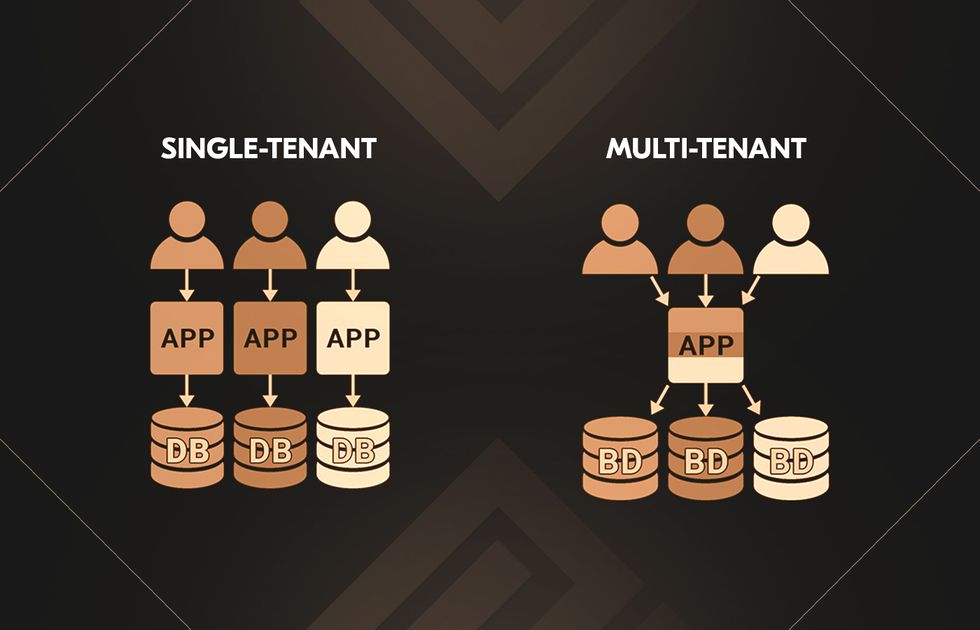
Key Takeaways
- A SaaS software stack combines programming languages, frameworks, libraries, and tools to build and run an application.
- When choosing a technology stack, consider the project’s size, code maintainability, and scalability requirements. Also, pay attention to time to market, security, reliability, and cost.
- The SaaS tech influences app performance. In particular, it impacts execution speed, scalability, and resource utilization efficiency.
Launching a new Software-as-a-Service (SaaS) project involves selecting the SaaS technology stack. It guarantees the project’s timely completion, operational stability, code maintainability, and scalability of the resulting product.
In this article, we will explain how to choose the best SaaS tech stack based on your unique requirements and discover its key components. We will also explore how to save development time and costs using the BaaS (Backend-as-a-Service) solution.
Why Picking the Right SaaS Tech Stack Is so Important
The SaaS market is expected to reach $1,251.35 billion by 2034, growing at a CAGR of 13.32% from 2025’s $408.21 billion. And this swift growth is not surprising. In 2024, global organizations utilized an average of 177 communication, sales, fintech, and other applications. One of the ways to overcome this competition is to choose the best tech stack for SaaS solutions.

A technology stack comprises programming languages, libraries and frameworks, cloud computing services, and databases. Its primary role is to create and maintain a web or mobile app.
In fact, the tech stack plays a big role in how much a project costs and how fast it gets off the ground. Some tools and frameworks make it easier to build and launch quickly, while others can slow things down or add extra costs. It also affects long-term upkeep, so choosing well-supported, scalable technologies can save time and money down the line.
According to Oleksii Glib, Founder of Acropolium, “The technology stack you select dictates the abilities and limitations your SaaS project will have, as well as its versatility and customizability. Some companies and clients like to pick unique stacks for their projects, but this will only make maintenance and product support harder and more expensive down the road.”
Things to Consider when Choosing a SaaS Technology Stack
Here are the most critical factors to consider when choosing a software as a service tech stack:

- Choose the stack your dedicated team is familiar with. This way, you will deliver the product and introduce new features or rapidly change existing ones. When the tools are familiar, there’s less time spent learning and more time building. It keeps things moving smoothly, boosts productivity, and makes ongoing maintenance a lot easier.
- Introduce new features to production seamlessly, with minimal human interaction, and in a predictable, error-free way. As user numbers climb and features get more complex, the stack should be able to scale without sacrificing performance. For example, use Continuous Delivery DevOps tools.
- Automate scaling and managing production and staging environments, requiring minimal human effort.
- Onboard new team members quickly and ensure their productivity in as little time as possible.
- Verify whether the technology you select has a predictable future. It’s important that the tech stack integrates easily with other tools and systems. For growing SaaS companies, seamless integration is essential, as complex, in-house workarounds can slow things down. Choosing the right stack helps ensure everything works together smoothly as the business expands. Otherwise, you will have to replace the language or framework in a couple of years when its support stops.
Also, consider hiring IT outsourcing consultants to analyze project requirements and select the most appropriate solution.
Here’s an example of choosing the most appropriate tech stack for SaaS projects from Acropolium’s experience.
Microsoft introduced Silverlight as an alternative to insecure Flash. It didn’t work for us, so we shifted to HTML5. Its versatile functions quickly made it mainstream, leaving companies using Silverlight with an outdated technology that’s challenging to support.
The same happened to Ruby on Rails. When it came out, clients worldwide asked software vendors to use RoR for their projects and even migrate existing apps. However, this solution turned out to be complicated. Therefore, engineers preferred Node.js.
How Tech Stack Influences App Performance
Now, let’s overview the pivotal impact of a tech stack on app performance in greater detail.
- SaaS programming language and web frameworks in your tech stack directly affect the response times and user responsiveness.
- The database management system (DBMS) choice influences how efficiently your SaaS application stores and retrieves data.
- Well-optimized frontend code ensures a smooth and responsive user interface, enhancing the overall experience.
- Implementing effective caching mechanisms improves performance, reducing the need to fetch data from slower storage systems.
- Server configuration and load-balancing mechanisms influence how your application handles concurrent users.
- Cloud platforms provide tools to scale resources based on demand, ensuring consistent performance during traffic spikes.
Key Components of a SaaS Tech Stack
Each tech stack consists of frontend and backend solutions. Let’s look at these components in more detail.

The Frontend of a SaaS
The Frontend is what users interact with, so performance, design, and responsiveness really matter. Frameworks like React, Vue.js, and Angular are go-to options for building dynamic, user-friendly interfaces.
They allow developers to create modular, reusable components, which speeds up development and makes updates easier. Styling is often handled with tools like Tailwind CSS or Bootstrap to maintain a clean and consistent look.
For example, Asana uses React to power its frontend, helping deliver a smooth and responsive user experience for task and project management across devices. Similarly, Dropbox relies on React and Redux to manage complex UI interactions efficiently.
Frontend Technology Breakdown
React. A JavaScript library developed by Facebook for building interactive user interfaces. React is component-based, making it ideal for scalable frontends where reusability and state management are important.
Vue.js. A lightweight, progressive JavaScript framework that’s great for building responsive user interfaces. It’s easy to integrate and has a gentle learning curve, making it popular for smaller teams or rapid development.
Angular. A full-featured framework maintained by Google. Angular is suited for large-scale applications and offers built-in tools for routing, state management, and form handling.
Tailwind CSS. A utility-first CSS framework that allows developers to style elements directly in the HTML. It speeds up styling and ensures consistent design across the app.
Bootstrap. A widely used CSS framework that includes pre-built components and responsive grid systems. Great for quickly designing clean, mobile-friendly interfaces.
The Backend of a SaaS
The backend is responsible for handling authentication, server logic, databases, APIs, and integrations. Popular backend languages and frameworks include Node.js, Python (with Django or Flask), Ruby on Rails, and Java (often with Spring Boot). The backend connects to databases like PostgreSQL, MySQL, or MongoDB, depending on data needs and scale.
Cloud platforms such as AWS, Google Cloud, or Azure are used to host and scale backend services. Technologies like Docker and Kubernetes help manage deployments and keep everything running smoothly.
Take Slack, for instance. They use Java on the backend along with MySQL and Redis to support real-time messaging. Spotify, on the other hand, combines Python and Java, using Google Cloud Platform to manage and scale their services effectively.
Now, let’s quickly break down the key points about the backend:
- Software as a service programming language and frameworks. The most popular backend programming languages and their frameworks are Java, C#, Python (Django, Flask), PHP (Laravel, Symphony), and JavaScript.
- Server. You will likely choose Apache, IIS, and Nginx, which can run on-premises or in AWS, Google Cloud, Microsoft Azure, DigitalOcean, etc.
- Database. Examples of database technologies include MySQL, Redis, MongoDB, and PostgreSQL. In addition, NoSQL and SQL databases are available.
- DevOps tools. To build Continuous Integration/Continuous Delivery pipelines (CI/CD), you will need Terraform, Docker, Kubernetes, Ansible, Jenkins, ELK stack, Prometheus + Grafana, and more.
- AI/ML. Your SaaS can benefit from in-detail data analytics powered by purpose-built AI algorithms. Such services are available on AWS, Google Cloud, Microsoft Azure. Alternatively, you can build them using a variety of SaaS Python, R, or Go libraries. But it requires advanced tech skills and knowledge.
- Event brokers. Kafka or RabbitMQ streamlines backend events in CQRS architectures, distributed data sources, and other complex backend structures.
Backend Technology Breakdown
Node.js. A JavaScript runtime that allows developers to run JavaScript on the server. It’s known for being fast and lightweight, often used in real-time applications like chats or notifications.
Python (Django / Flask). Python is a versatile language. Django is a full-featured web framework ideal for quickly building secure and scalable apps, while Flask is lighter and more flexible, giving developers more control over how things are structured.
Ruby on Rails. A developer-friendly web framework written in Ruby. It emphasizes convention over configuration, which speeds up development by reducing boilerplate code.
Java (Spring Boot). Java is known for performance and reliability. Spring Boot is a framework that simplifies backend development by reducing configuration and offering built-in tools for APIs, databases, and more. Common in large enterprise SaaS apps.
BaaS as a Way to Speed up Time to Market
Instead of designing and implementing complex backend systems for your SaaS, you can use BaaS from a specialized managed services provider. This way, you save time and costs without designing, building, and maintaining complex software. You also don’t need to hire and retain the talents necessary to do the job — the BaaS provider will cover that for you.
Software Architecture for SaaS Development
SaaS applications employ diverse architectures, each with its specific pros and cons.
Single-Tenant vs Multi-Tenant
Let’s discuss the most popular classification of architecture types:

- Single-tenant. With the single-tenant approach, you dedicate separate computational resources to each customer. Thus, everyone runs a particular instance and doesn’t have to share it with other tenants. This architecture is more secure but usually requires significant resources.
- Multi-tenant. With a multi-tenant approach, your customers share the same web-based app, database, and infrastructure behind it. This architecture is more resource-efficient but requires extra security measures. Besides, it simplifies updates, in-app marketing, A/B testing, and other business processes and activities.
Monolith vs. Microservices
The monolithic approach, with a single integrated codebase, is now considered obsolete, stimulating migration. In turn, microservices break the application into independent services, allowing separate development, testing, and deployment. Frameworks like Spring Boot, Eclipse Vert.x, GoMirco, and Micronaut streamline development, while Amazon ECS, Fargate, and Kubernetes enhance scalability.

Cloud Services
Choosing the right cloud service provider depends on specific business needs and technical requirements:
- Amazon Web Services (AWS) stands out as a leader, providing a comprehensive suite of pre-configured hosting technologies. It has a robust infrastructure and a rich set of services.
- Google Cloud Platform (GCP) is known for its data analytics and machine learning capabilities. It’s perfect for organizations with advanced technological requirements.
- Azure is popular among enterprises globally. It provides a comprehensive set of services, integration with Microsoft products, and a global network of data centers.
Event-Driven Architecture
In an event-driven architecture, an application focuses on user or system events. The program responds to an event by performing the specified function. This design processes events as they occur, making it scalable and efficient. However, it requires careful coordination and integration between different functions.
Factors that Influence the Choice of a Tech Stack for SaaS
When picking the optimal technology and SaaS web development stack, consider the following factors.

Code Maintainability
Going for a popular language and framework combination is a safer bet for a future-proof app. And even if new tools emerge daily, few of them deserve your attention. Ensure the technologies you choose are popular and have strong community support. Otherwise, you will likely need to reengineer your software in a few years.
Scalability Requirements
You may want to extend and improve your SaaS for a long time, but will it scale easily? Angular apps scale much better than those based on React. That’s because Angular was built with scalability in mind from the get-go.
Time to Market
The shorter the time to market is, the bigger the chances to outperform your competitors. So, select the technologies and approaches that boost your software delivery rate by automating and simplifying repetitive operations. It includes automated unit tests for code, CI/CD pipelines for environments, automated analytics, and more.
Security
Security is paramount in SaaS applications, especially when handling sensitive user data. The chosen tech stack should include robust security measures to protect against unauthorized access, data breaches, and other threats. Consider those with encryption, authentication, and authorization features.
Reliability
Adding backups and backup plans to the system ensures the application remains available, even when facing hardware failures or other issues. Reliable tech stacks include tools for monitoring the platform’s performance, identifying issues, and logging relevant events. Thanks to proactive monitoring, developers address potential problems before they impact users.
Cost
Cloud services like AWS, Azure, or Google Cloud offer scalable solutions. However, expenses vary depending on usage patterns and resources utilized. Some technologies may have associated licensing fees, while open-source solutions help mitigate these expenses. Also, some stacks have a steeper learning curve or require specialized expertise, impacting SaaS development costs.
Now, let’s overview how big companies choose their tech stacks:
- HubSpot relies on Amazon EC2 for server hosting. Recently, the company implemented Apache Mesos and Kubernetes to manage large EC2 clusters efficiently, optimizing server density and reducing costs. This approach addresses instance failures, providing insulation for developers from instance-specific details.
- As the user base has grown, Dropbox transitioned critical backends from Python to Go for enhanced concurrency and speed. Also, it brings high developer productivity with quick learning curves and easy maintenance. The team addressed library limitations by building open-source solutions for a wider audience.
- With trillions of data transactions per day, Netflix requires a combination of off-the-shelf solutions and in-house development. The company uses Memcached, Redis, and Hollow for short-lived in-memory storage. Cassandra and MySQL provide durable, searchable data stores. On top of that, developers have created additional Raigad and Priam sidecars for cluster deployment and management.
Acropolium’s Experience

Acropolium has built multiple SaaS solutions of different sizes. Based on our experience, here are the final considerations that influence the selection of the ideal tech stack:
- Product requirements. Select the most straightforward tools that get the job done, covering your unique product requirements.
- Software grade. Small, lightweight, and standalone apps are easy to build with any toolkit. However, enterprise-grade software has to support a wide range of integrations to form an ecosystem of products. Therefore, it requires C#, Java, and other heavy-duty tools.
- The existing skill set. Adding several missing talents to the team and using your in-house skills is much easier than hiring an entirely new team to deliver a product.
- One app — one subdomain. With this approach, you won’t need to adjust your company’s homepage whenever you launch a new product. This way, you streamline frontend-backend interactions.
Here are some examples of how Acropolium implemented these principles in real-life projects:
- Building a SaaS CMMS for remote device management for a healthcare provider
- Operational command SaaS software development
- Accounting software solution as a SaaS platform for financial business
How to Choose the Best Tech Stack for a SaaS Project
Choosing the right software as a service technology stack is a challenging feat. Searching out niche tools without LTS support is not a good idea. Instead, focus on selecting the most widely adopted, popular SaaS technology on the market.
They should not only meet your current project requirements but also align with your broader goals and future scalability needs. A tech stack chosen with strategic alignment in mind ensures your SaaS product can grow, evolve, and succeed in a dynamic market.
Acropolium is happy to lend our expertise and provide consulting on choosing a tech stack for the SaaS product you plan to build. We can offer BaaS services or help you develop a SaaS from scratch — our team has ample experience in both. So get in touch with us today to know more about our subscription-based service with a monthly fee.









![How to Build a SaaS MVP [2025 Step-by-Step Guide]](/img/articles/build-saas-mvp/img01.jpg)
![ᐉ SaaS Application Development [2025 Guide]](/img/articles/saas-application-development-2022/img01.jpg)
![Building Logistics SaaS Solutions [5 Use Cases & Key Benefits]](/img/articles/saas-for-logistics/img01.jpg)
![AI in SaaS: [How AI is Transforming the SaaS Landscape]](/img/articles/ai-in-saas-how-ai-is-transforming-the-saas-landscape/img01.jpg)
![ᐉ SaaS Development Outsourcing: [How to Scale Faster and Cut Costs]](/img/articles/outsource-saas-development/img01.jpg)
![Fintech SaaS Solutions in 2025 [Custom vs. Off-the-Shelf]](/img/articles/fintech-saas-solutions/img01.jpg)